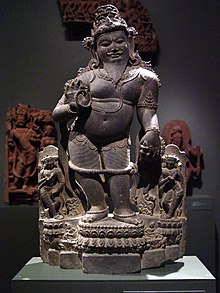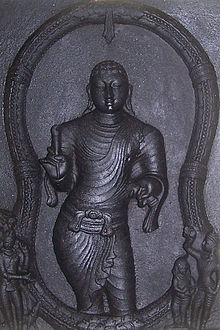
A | B | C | D | E | F | G | H | CH | I | J | K | L | M | N | O | P | Q | R | S | T | U | V | W | X | Y | Z | 0 | 1 | 2 | 3 | 4 | 5 | 6 | 7 | 8 | 9

The Sangam literature (Tamil: சங்க இலக்கியம், caṅka ilakkiyam, Malayalam: സംഘസാഹിത്യം, saṅgha sāhityam), historically known as 'the poetry of the noble ones' (Tamil: சான்றோர் செய்யுள், Cāṉṟōr ceyyuḷ),[1] connotes the early classical Tamil literature and is the earliest known literature of South India. The Tamil tradition and legends link it to three legendary literary gatherings around Madurai and Kapāṭapuram: the first lasted over 4,440 years, the second over 3,700 years, and the third over 1,850 years.[2][3] Scholars consider this Tamil tradition-based chronology as ahistorical and mythical.[4] Most scholars suggest the historical Sangam literature era, also called the Sangam period, spanned from c. 300 BCE to 300 CE,[2][5][6] while others variously place this early classical Tamil literature period a bit later and more narrowly but all before 300 CE.[7][8][9] According to Kamil Zvelebil, a Tamil literature and history scholar, the most acceptable range for the Sangam literature is 100 BCE to 250 CE, based on the linguistic, prosodic and quasi-historic allusions within the texts and the colophons.[10]
The Sangam literature had fallen into oblivion for much of the second millennium of the common era, but were preserved by and rediscovered in the monasteries of Hinduism, near Kumbakonam, by colonial-era scholars in the late nineteenth century.[11][12] The rediscovered Sangam classical collection is largely a bardic corpus. It comprises an Urtext of oldest surviving Tamil grammar (Tolkappiyam), the Ettuttokai anthology (the "Eight Collections"), the Pathuppaattu anthology (the "Ten Songs").[13] The Tamil literature that followed the Sangam period – that is, after c. 250 CE but before c. 600 CE – is generally called the "post-Sangam" literature.[8]
This collection contains 2381 poems in Tamil composed by 473 poets, some 102 anonymous.[13][14] Of these, 16 poets account for about 50% of the known Sangam literature,[13] with Kapilar – the most prolific poet – alone contributing just little less than 10% of the entire corpus.[15] These poems vary between 3 and 782 lines long.[12] The bardic poetry of the Sangam era is largely about love (akam) and war (puram), with the exception of the shorter poems such as in Paripaatal which is more religious and praise Vishnu and Murugan.[2][16][17] The Sangam literature also includes Buddhist and Jainist epics.[18]
Legendary Tamil Sangams
Sangam literally means "gathering, meeting, fraternity, academy". According to David Shulman, a scholar of Tamil language and literature, the Tamil tradition believes that the Sangam literature arose in distant antiquity over three periods, each stretching over many millennia.[19] The first has roots in the Hindu deity Shiva, his son Murugan, Kubera as well as 545 sages including the famed Rigvedic poet Agastya. The first academy, states the legend, extended over four millennia and was located far to the south of modern city of Madurai, a location later "swallowed up by the sea", states Shulman.[19][20] The second academy, also chaired by a very long-lived Agastya, was near the eastern seaside Kapāṭapuram and lasted three millennia. This was swallowed by floods. From the second Sangam, states the legend, the Akattiyam and the Tolkāppiyam survived and guided the third Sangam scholars.[19][20]
A prose commentary by Nakkiranar – likely about the eighth century CE – describes this legend.[21] The earliest known mention of the Sangam legend, however, appears in Tirupputtur Tantakam by Appar in about the seventh century CE, while an extended version appears in the twelfth-century Tiruvilaiyatal puranam by Perumparrap Nampi.[3] The legend states that the third Sangam of 449 poet scholars worked over 1,850 years in northern Madurai (Pandyan kingdom). He lists six anthologies of Tamil poems (later a part of Ettuttokai):[21]
- Netuntokai nanuru (400 long poems)
- Kuruntokai anuru (400 short poems)
- Narrinai (400 Tinai landscape poems)
- Purananuru (400 Outer poems)
- Ainkurunuru (500 very short poems)
- Patirruppattu (Ten Tens)
These claims of the Sangams and the description of sunken land masses Kumari Kandam have been dismissed as frivolous by historiographers. Noted historians like Kamil Zvelebil have stressed that the use of 'Sangam literature' to describe this corpus of literature is a misnomer and Classical literature should be used instead.[3] According to Shulman, "there is not the slightest shred of evidence that any such literary academies ever existed", though there are many Pandya inscriptions that mention an academy of scholars. Of particular note, states Shulman, is the tenth-century CE Sinnamanur inscription that mentions a Pandyan king who sponsored the "translation of the Mahabharata into Tamil" and established a "Madhurapuri (Madurai) Sangam".[22][note 1]
According to Zvelebil, within the myth there is a kernel of reality, and all literary evidence leads one to conclude that "such an academy did exist in Madurai (Maturai) at the beginning of the Christian era". The homogeneity of the prosody, language and themes in these poems confirms that the Sangam literature was a community effort, a "group poetry".[24][note 2] The Sangam literature is also referred sometimes with terms such as caṅka ilakkiyam or "Sangam age poetry".[3]
Historical Sangam period

In Old Tamil language, the term Tamilakam (Tamiḻakam, Purananuru 168. 18) referred to the whole of the ancient Tamil-speaking area,[web 1] corresponding roughly to the area known as southern India today, consisting of the territories of the present-day Indian states of Tamil Nadu, Kerala, parts of Andhra Pradesh and Karnataka. Sri Lanka is distinguished from it and is known as Ilam or Eelam,[26] although also influenced by the Sangam Period.[27][28][web 2][note 3]
In Indian history, the Sangam period or age (Tamil: சங்ககாலம், caṅkakālam) is the period of the history of ancient Tamil Nadu and Kerala (then known as Tamilakam), and parts of Sri Lanka from c. 300 BCE to 300 CE.[web 3] It was named after the literature of poets and scholars of the legendary Sangam academies centered in the city of Madurai.[29]
In the period between 300 BCE and 300 CE, Tamilakam was ruled by the three Tamil dynasties of Pandya, Chola and Chera, and a few independent chieftains, the Velir. The evidence on the early history of the Tamil kingdoms consists of the epigraphs of the region, the Sangam literature, and archaeological data.[28]
The fourfold Vedic system of caste hierarchy did not exist during the Sangam period. The society was organised by occupational groups living apart from each other.[30]
Corpus

Authors
The Sangam literature was composed by 473 poets, some 102 anonymous.[13] According to Nilakanta Sastri, the poets came from diverse backgrounds: some were from a royal family, some merchants, some farmers.[32] At least 27 of the poets were women. These poets emerged, states Nilakanta Sastri, in a milieu where the Tamil society had already interacted and inseparably amalgamated with north Indians (Indo-Aryan) and both sides had shared mythology, values and literary conventions.[32]
Compilations
The available literature from this period was categorised and compiled in the tenth century CE into two categories based roughly on chronology. The categories are the Patiṉeṇmēlkaṇakku ("Eighteen Greater Texts") comprising Ettuthogai (or Ettuttokai, "Eight Anthologies") and the Pattuppāṭṭu ("Ten Idylls") and Patiṉeṇkīḻkaṇakku ("Eighteen Lesser Texts"). According to Takanobu Takahashi, the compilation of Patiṉeṇmēlkaṇakku poems are as follows:[12]
| Name | Extant poems | Original poems | Lines in poems | Number of poets |
| Natrrinai | 400 | 400 | 9–12 | 175 |
| Kuruntokai | 402 | 400 | 4–8 | 205 |
| Ainkurunuru | 499 | 500 | 3–6 | 5 |
| Patirruppattu | 86 | 10x10 | varies | 8 |
| Paripatal | 33 | 70 | varies | 13 |
| Kalittokai | 150 | 150 | varies | 5 |
| Akananuru | 401 | 400 | 12–31 | 145 |
| Purananuru | 398 | 400 | varies | 157 |
| Name | Lines | Author |
| Tirumurukarruppatai | 317 | Nakkirar |
| Porunararruppatai | 234 | Mutattamakkanniyar |
| Cirupanarruppatai | 296 | Nattattanar |
| Perumpanarruppatai | 500 | Uruttirankannaiyar |
| Mullaippattu | 103 | Napputanar |
| Maturaikkanci | 782 | Mankuti Marutanar |
| Netunalvatai | 188 | Nakkirar |
| Kurincippattu | 261 | Kapilar |
| Pattinappalai | 301 | Uruttirankannanar |
| Malaipatukatam | 583 | Perunkaucikanar |
The compilation of poems from Patiṉeṇkīḻkaṇakku are as follows:
- Nālaṭiyār
- Nāṉmaṇikkaṭikai
- Iṉṉā Nāṟpatu
- Iṉiyavai Nāṟpatu
- Kār Nāṟpatu
- Kaḷavaḻi Nāṟpatu
- Aintiṇai Aimpatu
- Tiṉaimoḻi Aimpatu
- Aintinai Eḻupatu
- Tiṉaimalai Nūṟṟu Aimpatu
- Tirukkuṛaḷ
- Tirikaṭukam
- Ācārakkōvai
- Paḻamoḻi Nāṉūṟu
- Ciṟupañcamūlam
- Mutumoḻikkānci
- Elāti
- Kainnilai
Classification
Sangam literature is broadly classified into akam (அகம், inner), and puram (புறம், outer).[33] The akam poetry is about emotions and feelings in the context of romantic love, sexual union and eroticism. The puram poetry is about exploits and heroic deeds in the context of war and public life.[24][33] Approximately three-fourths of the Sangam poetry is akam themed, and about one fourth is puram.[34]
Sangam literature, both akam and puram, can be subclassified into seven minor genre called tiṇai (திணை). This minor genre is based on the location or landscape in which the poetry is set.[34] These are: kuṟiñci (குறிஞ்சி), mountainous regions; mullai (முல்லை), pastoral forests; marutam (மருதம்), riverine agricultural land; neytal (நெய்தல்) coastal regions; pālai (பாலை) arid.[34][35] In addition to the landscape based tiṇais, for akam poetry, ain-tinai (well matched, mutual love), kaikkilai (ill matched, one sided), and perunthinai (unsuited, big genre) categories are used.[34] The Ainkurunuru – 500 short poems anthology – is an example of mutual love poetry.[15]
Similar tiṇais pertain to puram poems as well, categories are sometimes based on activity: vetchi (cattle raid), vanchi (invasion, preparation for war), kanchi (tragedy), ulinai (siege), tumpai (battle), vakai (victory), paataan (elegy and praise), karanthai , and pothuviyal.[34] The akam poetry uses metaphors and imagery to set the mood, never uses names of person or places, often leaves the context as well that the community will fill in and understand given their oral tradition. The puram poetry is more direct, uses names and places, states Takanobu Takahashi.[36]
Style and prosody
The early Sangam poetry diligently follows two meters, while the later Sangam poetry is a bit more diverse.[37][38] The two meters found in the early poetry are akaval and vanci.[39] The fundamental metrical unit in these is the acai (metreme[40]), itself of two types – ner and nirai. The ner is the stressed/long syllable in European prosody tradition, while the nirai is the unstressed/short syllable combination (pyrrhic (dibrach) and iambic) metrical feet, with similar equivalents in the Sanskrit prosody tradition.[39] The acai in the Sangam poems are combined to form a cir (foot), while the cir are connected to form a talai, while the line is referred to as the ati.[41] The sutras of the Tolkappiyam – particularly after sutra 315 – state the prosody rules, enumerating the 34 component parts of ancient Tamil poetry.[41]
The prosody of an example early Sangam poem is illustrated by Kuruntokai:[42]
| Part of a series on |
| Hinduism |
|---|
 |
